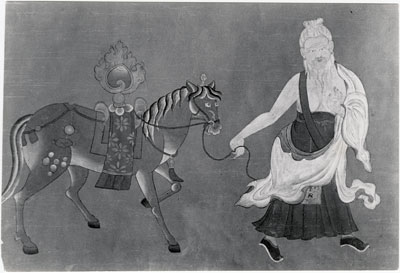
1998.131.333 (Print black & white)


1998.131.333 (Print black & white)

Frederick Spencer Chapman
Frederick Spencer Chapman
September 16th 1936
Lhasa > Norbu Lingka > Stables
1998.131.333
111 x 163
Print gelatin silver
Donated 1994
Faith Spencer Chapman
British Diplomatic Mission to Lhasa 1936-37
Frederick Spencer Chapman
CL.14 In publication
'Lhasa Mission 1936, Diary of Events', P. Neame, H. Richardson, F. S. Chapman, Government of India Political Department [Note: photographs for October 18th - November 4th 1936 are not included as their relationship to text is not detailed; see Mission Diary text for details of images] [see photos in publication]
SC.T.2.333
'Lhasa Mission 1936, Diary of Events', P. Neame, H. Richardson, F. S. Chapman, Government of India Political Department [Note: photographs for October 18th - November 4th 1936 are not included as their relationship to text is not detailed; see Mission Diary text for details of images] [view list of illustrations]
Notes on print/mount - The reference number 'CL/14' has been written on the back of the print in pencil [MS 21/03/2006]
Manual Catalogues - Caption in Chapman's hand-written list of negatives made whilst on the Mission to Lhasa, 1936-7 [See PRM Manuscripts Collection]: 'Horse frescoes [Norbu Lingka stables]' [MS 21/03/2006]
Other Information - Related Images: Images prefixed with 'CL' comprise a group of negatives containing images of a wooden pillar, tea pots, Tibetan mastiff, frescoes, lions at lake palace, frescoes in Norbu Lingka stables. They all seem to have been taken on about September 16th 1936 [MS 20/03/2006]
Other Information - Cultural Background: This image represents a part of Buddhist teaching; the horse being led by the reigns symbolises the taming of the mind [TS 7/2/2005]
Other Information - Description: "Perhaps the most surprising thing in all the Norbhu Lingka is the Dalai Lama's stables. The stalls are arranged along three sides of a cobbled courtyard and around another block in the centre. On each side of the entrance gateways are two paintings, the Mongolian leading a tiger, and, in a style that recalls an Italian primitive, a man followed by an amiable-looking elephant laden with symbolic jewels. These paintings one has seen elsewhere, but over every stall is the most enchanting fresco painted in bright colours on the plaster of the wall. Many of these are equestrian subjects ... One of the most interesting shows the anatomy of the horse. ... Other paintings illustrate Chinese proverbs and folk-tales: four figures are trying to move something that looks like an enormous peach; a boatload of people crossing a lake while an old man sits wrapped in thought, and a wisp of cloud flowing from his brain is developed to form a vision of the Buddha. // All these frescoes, though slightly splashed and discoloured, are marvellously executed and must be the work of first-class artists ... these equestrian studies exhibit a rate economy of line and colour and are quite unlike other work I saw in Lhasa" ['Lhasa: The Holy City', F. Spencer Chapman, London: Chatto & Windus, 1938, p. 188] [MS 21/03/2006]
For Citation use:
The Tibet Album.
"Painting in Norbu Lingka stables"
05 Dec. 2006. The Pitt Rivers Museum.
<http://tibet.prm.ox.ac.uk/photo_1998.131.333.html>.
For more information about photographic usage or to order prints, please visit the The Pitt Rivers Museum.
© The Pitt Rivers Museum